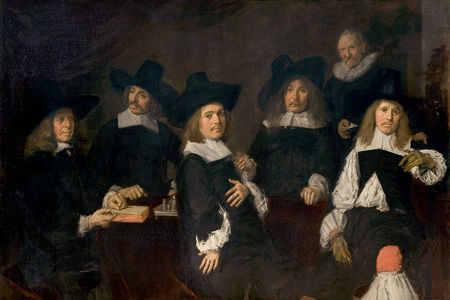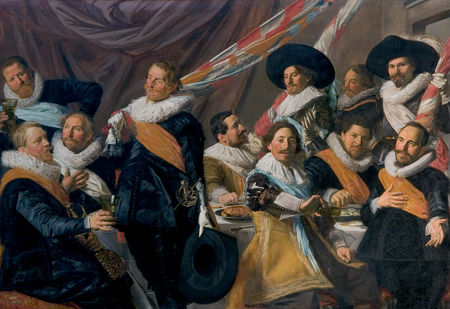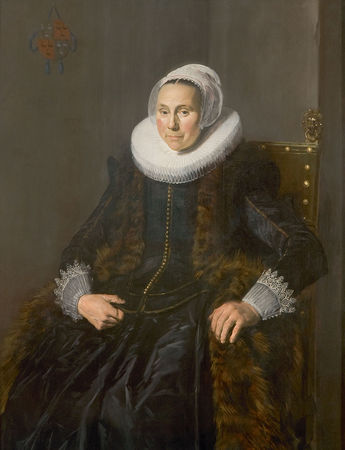The Frans Hals Museum Receives a Historic Gift of Art Worth More than €100 Million
Frans Hals, The Regents and Regentesses of St Elisabeth’s
HAARLEM.- The official handover of the largest gift in the museum’s recent history took place today in the Frans Hals Museum. The Elisabeth van Thüringen Fund is donating eleven works of art from the 16th, 17th and 18th centuries to the City of Haarlem and the Frans Hals Museum. Among the works there is a large and rare group portrait by Frans Hals. The total value of the gift is at least €100 million. The works can be seen in the exhibition ‘A Magnificent Gesture’ until 10 July.
The works, including the spectacular group portraits of the Regents and Regentesses of St Elisabeth’s or Groote Hospital by Frans Hals and Johannes Verspronck, have been hanging in the Frans Hals Museum for some time on loan from the Elisabeth van Thüringen Fund. The trustees of this fund are the direct descendants of the men and women portrayed in the paintings by Hals and Verspronck. Thanks to the extraordinarily generous gift from the Elisabeth van Thüringen Fund the most important works from this collection are now the property of the City of Haarlem and part of the museum’s collection. Director Karel Schampers of the Frans Hals Museum said, ‘A greater or more interesting gift is almost inconceivable – if for no other reason than that iconic group portraits like these by Hals and Verspronck are all in museum collections and will never come on to the market.’
Collected over Four Centuries
There are several reasons why the Elisabeth van Thüringen Fund decided to gift the eleven most important works from their collection to the Frans Hals Museum and the City of Haarlem. Peter van Barneveld, Senior Trustee of the Elisabeth van Thüringen Fund and Chairman of the Board of the Kennemer Hospital in Haarlem, explained, ‘These masterpieces belong to the cultural heritage of Haarlem and the Netherlands. The works need attention and conservation. They belong in a place where they can be exhibited as they deserve and the public will always be able to see them. The Frans Hals Museum is the right place for them.’
The collection was created four hundred years ago as the art collection of St Elisabeth’s or Groote Hospital (now the Kennemer Hospital). In 1977 the collected paintings and the historical objets d’art were placed in the Elisabeth van Thüringen Fund, which manages the collection. The Kennemer Hospital in Haarlem and Haarlem Local Authority are represented in this fund.
A Gift of €100 million
As well as the group portraits by Frans Hals and Johannes Verspronck, the gift includes two works by Maerten van Heemskerck, and paintings by Dirck Hals, Cornelis Cornelisz van Haarlem, Nicolaes Roosendaal, Adriaan Backer, Frans Decker and a follower of Joachim Patenier. The Elisabeth van Thüringen Fund has also donated a decorated charter box of St Elisabeth’s Hospital from around 1625.
Two paintings, The Regents of St Elisabeth’s or Groote Gasthuis by Frans Hals and the View of Rome with the Good Samaritan by Maerten van Heemskerck will be restored by the Frans Hals Museum in the near future.
Frans Hals (Antwerpen ca 1582 - Haarlem 1666), The Regents and Regentesses of St Elisabeth’s, 1641, canvas, 153 x 252 cm, on loan from the Elisabeth van Thüringen
Frans Hals masterpieces in Frans Hals museum:
Frans Hals (Antwerpen ca 1582 - Haarlem 1666), The regents of the Old Men's Home in Haarlem, 1664, canvas, 172,3 x 256 cm
The Old Men's Alms House was a home where men over the age of sixty could spend their declining years. The home opened its doors to the first residents in 1609. The building, in Groot Heiligland, still exists and is now the Frans Hals Museum. In 1664 Frans Hals painted the portraits of the regents and regentesses who made up the board of trustees of the Old Men's Alms House in that year. The regents sit around a table covered with a dark red tablecloth. The housefather stands on the right in the background. He and the housemother were responsible for the day to day running of the institution. Hals's less than precise manner of painting - characteristic of his later work - provoked great criticism in the 19th century. It was said that he was too old to paint. Frans Hals was over eighty when he made this portrait. The second regent from the right has an odd look in his eyes. In the 19th century it was thought that he had been portrayed drunk, but nowadays experts believe that he was suffering from facial paralysis.
Frans Hals (Antwerpen ca 1582 - Haarlem 1666), The regentesses of the Old Men's Home in Haarlem, 1664, canvas, 170,5 x 249,5 cm
The four regentesses who were part of the board of trustees of the OId Men's Alms House in 1664 were Adriaentje Schouten, Marijtje Willems, Anna van Damme and Adriana Bredenhoff. They are portrayed, with the housemother, in this group portrait by Frans Hals. The painting in the background may be of the Good Samaritan, a subject that illustrates the charity of the regentesses. The portraits of the regentesses and the regents have been both admired and reviled over the centuries - admired for the manner of their painting, which had a particularly marked impact on the Impressionists and Realists of the 19th century, and reviled because people thought that the portraits of the regentesses were not very flattering. For a long time it was believed that Frans Hals had lived in the Old Men's Alms House. It was said that this portrait of the regentesses and that of the regents were his way of taking his revenge on the strict trustees. But Frans Hals never lived in the Old Men's Alms House. We do, however, know that in the 1630s Frans Hals and his large family lived in Groot Heiligland, the street where the Old Men' s Alms House stood.
Frans Hals (Antwerpen ca 1582 - Haarlem 1666), Banquet of the officers of the St George Civic Guard 1616, canvas, 175 x 234 cm
Hals' s first civic guard painting: the officers of the Civic Guard of St George at their farewell banquet. These officers served from 1612 to 1616. Frans Hals has used a straightforward composition to show the hierarchy among the officers. The tip of the flag is the top of an imaginary pyramid within which the officers are ranged. On the left at the head of the table sits the colonel, with the provost marshal on his right. They are the highest-ranking officers. Then come the three captains and finally the three lieutenants. Around them stand the three ensigns and the servant. Ensigns, usually young men of good family, were the only members to stay for longer than three years; they could keep their position as long as they were unmarried. Two ensigns in this painting, Boudewijn van Offenberg and Jacob Schout, were still ensigns in 1627, and also appear in the painting of the Civic Guard of St George dating from 1627. The ensigns carry the flags of the Civic Guard of St George, blue and yellow chequers at the top, and red and white stripes at the bottom, with the arms of Haarlem in the centre. The seated captain in the foreground is Nicolaes van der Meer. Frans Hals painted his portrait again in 1631, together with that of his wife, Cornelia Vooght.
Frans Hals (Antwerpen ca 1582 - Haarlem 1666), Officers and sub-alterns of the Calivermen Civic Guard, 1633, canvas, 207 x 337 cm.
Frans Hals Officers and sergeants of the Cluveniers meeting outdoors. The highest in rank are positioned in the foreground: the colonel, captains and lieutenants. The sergeants are allocated a place behind the table; this is the first time that Frans Hals also portrayed non-commissioned officers. The two groups in the composition are linked by Lieutenant Jacob Buttinga (5) centre, in front of the table. He belongs to the group on the left, with the colonel as the central point, but turns to Van der Horn, who is at the centre of the right-hand group. The officers of the guard carry the weapons that accompany their posts: the colonel leans on his commander's staff, the captains carry pikes with tassels, and the sergeants have halberds. Captain Johan Schatter (2) had been a captain in the Cluveniers before. He is also depicted in the civic guard portrait of the Cluveniers dating from 1627. Colonel Johan Claesz Loo (1) and Lieutenant Hendrick Gerritsz Pot (7) both also appear in the civic guard portrait of 1639. The painting must originally have been much more colourful. This is particularly evident in the trees in the background: they were once green but have discoloured to brown over the centuries.
Frans Hals (Antwerpen ca 1582 - Haarlem 1666),, Banquet of the officers of the St George Civic Guard, 1624-1627, canvas, 179 x 257,5 cm
The officers who served in the Civic Guard of St George from 1624 to 1627 attend their farewell banquet. Officers were appointed for three years by the town council. The end of their term of office was marked with a banquet. The officers and ensigns wear sashes in the colours of their company: white, orange or blue. The place of honour, in the foreground and at the head of the table, is occupied by the colonel, Aernout Druyvesteyn. A place in the foreground is a1so reserved for Ensign Boudewijn van Offenberg (8), Captain Michiel de Wael (2) and Captain Nicolaes le Febure (3) . It was these men who in 1625 had taken part in an expedition of both Haarlem civic guards to Heusden in North Brabant to provide reinforcements. Their participation in this 'action' may have prompted the commissioning of this group portrait. The officers of the Cluveniers also had a civic guard portrait painted at the end of this period of office. Captain Le Febure (3) is shown standing so that it is not obvious just how short he was. Boudewijn van Offenberg (8) and Jacob Schout (10) are also portrayed in the civic guard portrait of 1616. They were standard-bearers from 1612 to 1627.
Frans Hals (Antwerpen ca 1582 - Haarlem 1666), Officers and sub-alterns of the St George Civic Guard, 1639, canvas, 218 x 421 cm
portraits of the civic guard.
Frans Hals (Antwerpen ca 1582 - Haarlem 1666), Portrait of Nicolaes Woutersz van der Meer, 1631, panel, 128 x 100,5 cm
Nicolaes van der Meer and Comelia Vooght were a prominent Haarlem couple. Van der Meer (1574-1637)was a brewer, sheriff, burgomaster on more than one occasion and an officer of the civic guard. In his post of captain he was also painted by Frans Hals in the civic guard portrait of 1616. The couple were portrayed in two separate paintings, which belong together. The wall in one portrait appears to continue through into the other. Traditionally the portrait of the man hangs on the left and that of the woman on the right. In the course of his long career, Frans Hals painted many of these pendant portraits of men and women. There is something strange going on with these two portraits. X-rays have revealed that the faces of Nicolaes and Cornelia have been painted over the top of other portraits. We do not know why this was done. Perhaps the sitters were not satisfied or became dissatisfied with their portraits; perhaps later owners (the portraits remained in the family far a long time) had the portraits altered. The coats of arms in the two paintings are also later additions, probably 19th century. The Prussian blue pigment used in the coats of arms was not in general use until after 1720, and the arms are not in evidence on a drawing after the portrait of Cornelia Vooght made by Johan van der Sprang in 1762.
Frans Hals (Antwerpen ca 1582 - Haarlem 1666), Portrait of Cornelia Claesdr Vooght, 1631, panel, 126,5 x 101 cm.
Nicolaes van der Meer and Comelia Vooght were a prominent Haarlem couple. Van der Meer (1574-1637)was a brewer, sheriff, burgomaster on more than one occasion and an officer of the civic guard. In his post of captain he was also painted by Frans Hals in the civic guard portrait of 1616. The couple were portrayed in two separate paintings, which belong together. The wall in one portrait appears to continue through into the other. Traditionally the portrait of the man hangs on the left and that of the woman on the right. In the course of his long career, Frans Hals painted many of these pendant portraits of men and women. There is something strange going on with these two portraits. X-rays have revealed that the faces of Nicolaes and Cornelia have been painted over the top of other portraits. We do not know why this was done. Perhaps the sitters were not satisfied or became dissatisfied with their portraits; perhaps later owners (the portraits remained in the family far a long time) had the portraits altered. The coats of arms in the two paintings are also later additions, probably 19th century. The Prussian blue pigment used in the coats of arms was not in general use until after 1720, and the arms are not in evidence on a drawing after the portrait of Cornelia Vooght made by Johan van der Sprang in 1762.
Frans Hals (Antwerpen ca 1582 - Haarlem 1666), Portrait of Pieter Jacobsz Olycan, ca 1630, panel, long term loan private collection.
A portrait of a mayor of Haarlem with a rather unusual slant. This painting was damaged while Frans Hals was working on it, as is apparent from the deep scratches in the background on the right. As a result of the damage large pieces of panel had to be sawn off on the right and the bottom. It changed from being a portrait from the knee up, to one that started at the chest. A hand was then painted in later to add balance to the composition. Under the mayoral robe other clothing can be seen. It appears that Hals started work on the portrait before Olycan's inauguration in 1630 and then added the robe later.

/https%3A%2F%2Fprofilepics.canalblog.com%2Fprofilepics%2F1%2F0%2F100183.jpg)
/https%3A%2F%2Fstorage.canalblog.com%2F03%2F02%2F119589%2F96711876_o.jpg)
/https%3A%2F%2Fstorage.canalblog.com%2F11%2F31%2F119589%2F94773502_o.jpg)
/https%3A%2F%2Fstorage.canalblog.com%2F20%2F83%2F119589%2F94772815_o.jpg)
/https%3A%2F%2Fstorage.canalblog.com%2F26%2F72%2F119589%2F75604929_o.jpg)
/https%3A%2F%2Fstorage.canalblog.com%2F59%2F60%2F119589%2F26458628_o.jpg)













/http%3A%2F%2Fstorage.canalblog.com%2F71%2F05%2F119589%2F70089339_o.jpg)
/http%3A%2F%2Fstorage.canalblog.com%2F27%2F43%2F119589%2F30197442_o.jpg)
/http%3A%2F%2Fstorage.canalblog.com%2F42%2F89%2F119589%2F129853759_o.jpg)
/http%3A%2F%2Fstorage.canalblog.com%2F19%2F23%2F119589%2F128179837_o.jpg)